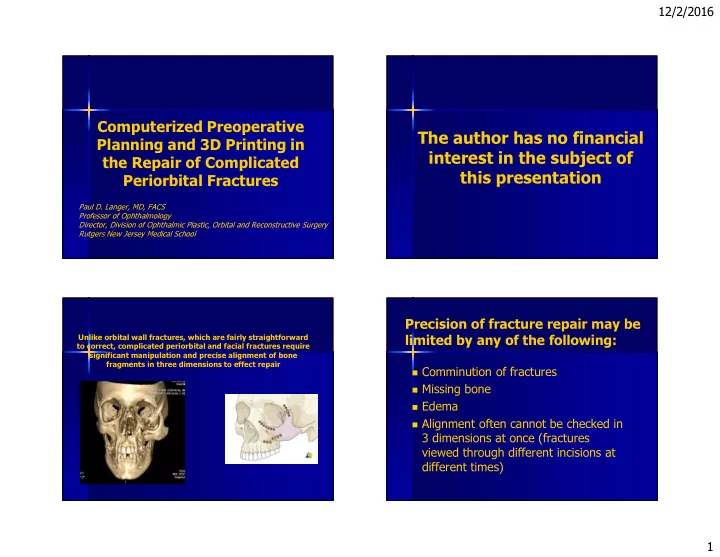

12/2/2016 Computerized Preoperative The author has no financial Planning and 3D Printing in interest in the subject of the Repair of Complicated this presentation Periorbital Fractures Paul D. Langer, MD, FACS Professor of Ophthalmology Director, Division of Ophthalmic Plastic, Orbital and Reconstructive Surgery Rutgers New Jersey Medical School Precision of fracture repair may be Unlike orbital wall fractures, which are fairly straightforward limited by any of the following: to correct, complicated periorbital and facial fractures require significant manipulation and precise alignment of bone fragments in three dimensions to effect repair � Comminution of fractures � Missing bone � Edema � Alignment often cannot be checked in 3 dimensions at once (fractures viewed through different incisions at different times) 1
12/2/2016 Additive Manufacturing Pre-operative Planning � Now synonymous with “3-D printing” � Any manufacturing process that transforms a 3D 1) Virtual, computer-assisted manipulation model into a physical object of bone fragments allows for precise, � Joins successive layers of the same material under automated control preoperative alignment of fragments � Contrasts with traditional manufacturing techniques, which are “subtractive” 2) 3-dimensional models and intraoperative guides are produced with stereolithography Traditional “subtractive” that assist in translating the precise virtual manufacturing: repair to the actual repair Additive Manufacturing Additive Manufacturing Term encompasses many different technologies including sintering, � laminated object manufacturing, fused deposition modelling, and stereolithography, among others Advantages: All have an essential manufacturing principle in common: a machine � reads a design from a 3D printable file (“STL file”) and lays down No need for molds/dyes—prototypes made successive layers of liquid, powder, paper or sheet material to build the model from a series of cross sections on demand, design changes made without These layers (corresponding to the virtual cross sections from the CAD � model) are joined or automatically fused to create the final shape. adding cost � The primary advantage of this technique is its ability to create almost any shape or geometric feature Design changes enacted quickly and easily— tooling/machining constraints eliminated Fused deposition modelling: 1 – nozzle ejecting molten plastic, 2 – deposited material (modeled part), 3 – controlled movable table 2
12/2/2016 Stereolithography Pre-operative Planning A laser beam traces a cross section of the part over the surface of a � photoreactive resin (photopolymer) which lies in a vat 1) Virtual, computer-assisted manipulation Immediately upon contact with the UV light, the resin is “cured” � of bone fragments allows for precise, (hardended) After the pattern is traced, the part descends into the vat by the � preoperative alignment of fragments thickness of a “single layer;” the process is then repeated, with the laser drawing out the next cross section, which hardens and is joined to the layer beneath 2) 3-dimensional models and intraoperative At the end of the process, the entire object is � formed and completely submerged in the tank guides are produced with stereolithography that assist in translating the precise virtual repair to the actual repair Pre-operative Planning � Maxillofacial CT scan of the patient (1.25mm cuts maximum) is sent to 3-D printing company (Materialise), which converts it to STL � 3-D virtual model is created on a computer � In conference call, bone fragments can be moved on the computerized 3-D image in any direction, rotated, removed, etc, to effect final desired result 3
12/2/2016 4
12/2/2016 Pre-operative Planning 1) Virtual, computer-assisted manipulation of bone fragments allows for precise, preoperative alignment of fragments 2) 3-dimensional models and intraoperative guides are produced with stereolithography that assist in translating the precise virtual repair to the actual repair 5
12/2/2016 6
12/2/2016 7
12/2/2016 8
12/2/2016 9
12/2/2016 10
12/2/2016 Pre-operative Planning Pre-operative Planning Advantages Future Directions Allows for presurgical preparedness � � Computerized 3-dimensional reconstruction Promotes precise surgical alignment and reduces � programs are not proprietary—each hospital will guesswork have one Promotes flexibility in surgical options � � 3D printers are cheaper each year Reduces surgical time � � Once pre-operative computerized planning becomes commonplace, hospitals will likely Disadvantages purchase own computer programs, have � Cost (several thousand dollars) biomedical engineers in-house, and print own � Time (need 5 working days for all models and planning) models 11
Recommend
More recommend